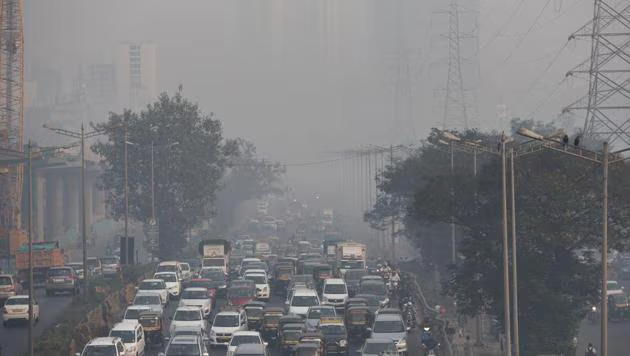Mumbai, India: A latest report by Greenpeace India, “Beyond North India: NO₂ Pollution and Health Risks in Seven Major Indian Cities”, reveals alarming levels of nitrogen dioxide (NO₂) pollution in Mumbai.
Nitrogen dioxide (NO₂) is a near-invisible toxic gas closely linked to traffic and fuel burning, common in urban areas. That means vehicles and energy generation from fossil fuel are important sources of NO₂.
In 2023, the city’s annual average NO2 concentration exceeded the WHO health guideline at 22 of 24 Continuous Ambient Air Quality Monitoring Stations (CAAQMS). Malad West recorded the highest levels, followed by Bandra Kurla, a roadside station near a bus depot. Daily NO2 averages also surpassed the guideline, with Mazgaon and Sion exceeding the limit for over 70% of the year. Mazgaon recorded 267 days above the limit.
Overwhelming scientific evidence links NO₂ exposure to adverse health impacts such as risk of asthma, airway inflammation, respiratory irritation, and the worsening of existing respiratory conditions. It can impair lung development, intensify allergies and increase susceptibility to respiratory mortality and death from circulatory diseases, ischemic heart disease, and even lung cancer. Children who make up to 10% population are the most affected by the continuous exposure to unhealthy concentrations of NO₂. Achakulwisut et al. (2019) estimated that 3,970 cases of paediatric asthma could be attributed to NO2 pollution in Mumbai in 2015.
“This report underscores a crucial truth: air pollution is not limited to Delhi or North India. The transportation sector is the largest contributor to high NO₂ levels across cities in India. As cities grow, the rise in private vehicles worsens air quality and jeopardizes public health. To tackle this, we need a fundamental shift towards a sustainable, efficient public transportation system. Investing in cleaner, more accessible transit options is not just an environmental necessity—it’s an urgent public health imperative. The government must prioritize cleaner mobility solutions to ensure a healthier future, said Selomi Garniak, Climate Justice Campaigner at Greenpeace India.
Annual average NO2 concentrations for all CAAQM monitors in Mumbai, 2023. Monitoring stations we classified as roadside are shown in dark blue.
India’s response to air pollution, especially NO2 pollution, falls short of global health standards. The country’s National Ambient Air Quality Standards (NAAQS) are less stringent than WHO guidelines and have not been updated in 15 years, leaving millions vulnerable to the harmful effects of poor air quality.
To address the air pollution crisis in cities like Bengaluru, Hyderabad, Chennai, Mumbai, Kolkata, and Pune, Greenpeace India recommends a region-specific approach. This includes updating NAAQS, strengthening primary healthcare to diagnose pollution-related conditions, implementing a health advisory system, and prioritizing interventions for vulnerable groups (children, elderly, pregnant women, outdoor workers, and those with pre-existing conditions).
Air pollution is a growing public health threat in India, requiring bold, innovative solutions. One such solution is an affordable ‘Clean Air Concession’ for public transportation. By making mass transit more accessible, this policy can encourage people to leave their cars behind, reducing congestion and harmful emissions. This simple measure can significantly improve air quality, public health, and create more inclusive, healthier cities, said Aakiz Farooq Mobility campaigner at Greenpeace.
Local governments should focus on reducing vehicular emissions by improving public transport, such as offering free travel for women. Investment should also be directed toward developing hybrid air quality monitoring networks that combine low-cost sensors, existing systems, and satellite data to track progress and support effective interventions.
Key highlights
1. The city’s 2023 annual average NO2 concentration exceeded the WHO health based guideline at 22 out of 24 CAAQM monitoring stations.
2.The station with the highest NO2 annual average was Malad West was classified as a roadside station, located near a bus depot.
3.Two stations (Mazgaon and Sion) measured daily average NO2 concentrations higher than this guideline over 70% of the year, with Mazgaon recording 267 days.
4. Previously researchers have estimated that exposure to NO2 may be linked to as many as 3,970 cases of paediatric asthma in Mumbai in 2015.
5. Apart from the revisions in NAAQS there should be focus on strengthening primary healthcare services ability to diagnose air pollution related conditions.
6.There must be a comprehensive health advisory system, community education and timely alerts to the public during high pollution periods & prioritising health interventions for vulnerable groups, including children, the elderly, pregnant women, outdoor workers and individuals with pre existing conditions.
Disclaimer: This media release is auto-generated. The CSR Journal is not responsible for the content.


